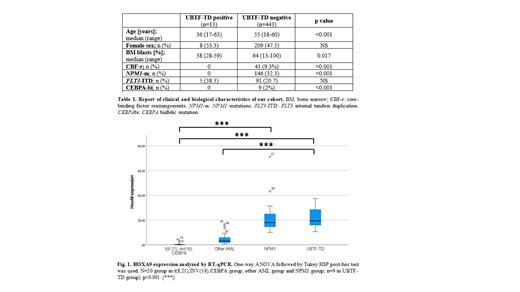Background
Upstream Binding Transcription Factor ( UBTF) gene plays an important role in ribosomal RNA transcription. UBTF tandem duplications (TD) have been recently described as a recurrent genetic lesion in acute myeloid leukemia (AML). UBTF-TDs appear to be mutually exclusive with other class-defining lesions in AML and display a unique comutational signature. UBTF-mutated AML affects predominantly younger patients and is associated with trisomy 8, internal tandem duplication of FLT3 ( FLT3-ITD), mutations in WT1 and poor prognosis. Moreover, HOX and MEIS genes seem to be overexpressed in AML with UBTF-TD similarly to NPM1-mutated ( NPM1m) or KMT2A-rearragend ( KMT2Ar) AML, suggesting potential sensitivity to menin inhibitors. In this study we sought to characterize UBTF-TDs in our AML cohort.
Methods
We studied 456 adult patients (median age 54 years; range 18-70) diagnosed with de novo AML and included in AML-12 protocol from CETLAM group. All patients from the 2012-2017 period (n=403) were consecutively studied and we also selected 53 cases of WT1-mutated AML from the 2017-2020 period, given the strong association with UBTF-TD. Screening for UBTF-TD was performed on bone marrow (BM) or peripheral blood (PB) genomic DNA samples. Exon 13 of UBTF gene was amplified and analysed by Polymerase chain reaction (PCR) and subsequent fragment length analysis by capillary electrophoresis. Mutated samples were confirmed through Sanger sequencing. Further, RNA from 9 UBTF-TD cases was available and HOXA9 and MEIS1 gene expression analysis was performed by Real-Time Polymerase Chain Reaction (RT-qPCR). Clinical and biological data were obtained from CETLAM registry.
Results
UBTF-TD was found in 13 patients from our cohort whose characteristics are detailed in Table 1. UBTF-TDs range from 45 base pairs (bp) to 365 bp, being the 48 bp the most recurring size. As described, although small UBTF-TDs are in frame insertions, the largest ones are not multiple of 3. Notably, most UBTF-TDs presented small insertions and deletions among the duplication.
Presence of UBTF-TD was associated with younger age (36 vs 55 years; p<0.001) and BM dysplastic changes (80% of U BTFMUT). UBTF-TD was particularly frequent (8.9% of all cases) in patients below 40 years, compared to other lesions as CEBPA mutations (1.1%).
Eleven (85%) U BTFMUT patients presented intermediate cytogenetics, being trisomy 8 (5), normal karyotype (3) and 9q deletion (2) the most recurrent findings. Two cases of adverse karyotype with MECOM-rearrangements were found. As previously described, there was a strong association between UBTF-TD and of FLT3-ITD (38.5%). Other recurrent genetic lesions in AML like NPM1 and CEBPA mutations or core-binding factor (CBF) rearrangements were exclusive of UBTF wild type patients.
Further, we found that UBTFMUT leukemias showed marked overexpression of HOXA9 compared with other AML subtypes (22.1-fold vs 5.0-fold; p<0.001; Fig. 1) and similar to NPM1m AML (22.3-fold). On the other hand, MEIS expression did not differ significantly among groups.
Conclusions
In our cohort of adult AML patients, UBTF-TDs are found in 1.8% of cases and are especially frequent in younger individuals in absence of other class-defining genetic lesions. The presence of UBTF-TD is strongly associated with cytomorphological dysplasia and co-occurrence of FLT3-ITD and WT1 mutations, while NPM1 and CEBPA mutations and CBF rearrangements appear to be mutually exclusive. HOXA9 upregulation could be a leukemogenic event in UBTF-TD AML, as described in NPM1-m and KMT2A-r AML, suggesting potential utility of menin inhibitors in this subset of patients. Screening for UBTF-TD is going to be incorporated in our molecular diagnostic panel for new AML cases.
Disclosures
Salamero:Pfizer: Consultancy, Honoraria; Astellas: Consultancy, Honoraria; Abbvie: Consultancy, Honoraria; Jazz: Consultancy, Honoraria; BMS: Consultancy, Honoraria. Tormo:BMS: Honoraria; AbbVie: Honoraria; Pfizer: Honoraria; MSD: Honoraria; Astellas: Honoraria. Esteve:Jazz Pharmaceuticals: Consultancy, Research Funding; Astellas: Consultancy; Gilead: Consultancy; Pfizer: Research Funding; Kronos Bio: Research Funding; Abbvie: Consultancy.


This feature is available to Subscribers Only
Sign In or Create an Account Close Modal